This is the same male Short-eared Owl I posted a single photo of two days ago. Reader Dan Gleason asked a question in his comment on that post that prompted me to research my other photos of the bird. I couldn’t find one like he was requesting to see but I did stumble across these images illustrating an interesting behavior. Years ago I documented this same bird performing a similar behavior but that was a different event and these photos are new to my blog.
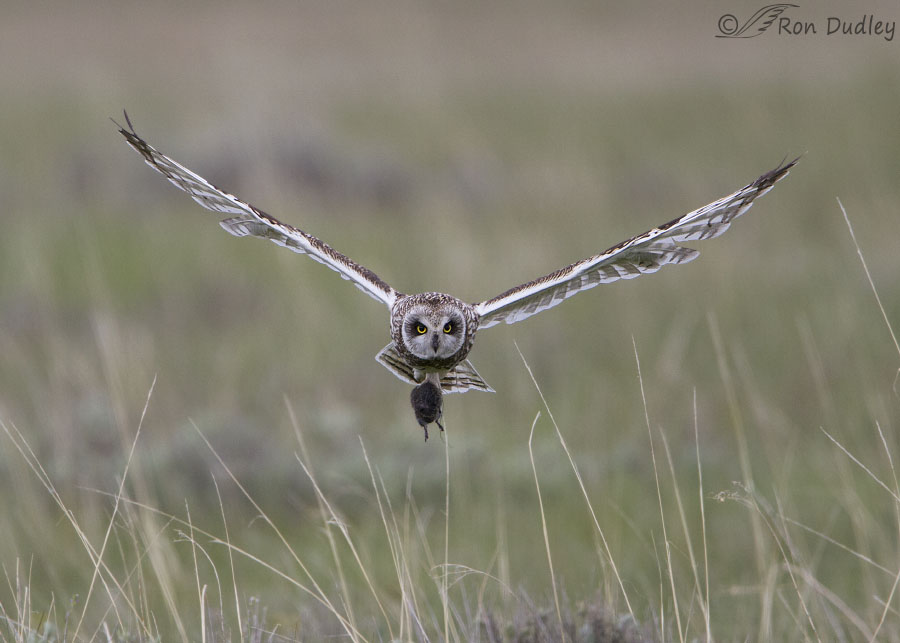
1/1250, f/5.6, ISO 800, Canon 7D, Canon EF 500mm f/4L IS USM + EF 1.4 III Extender, not baited, set up or called in
Occasionally the male would catch a vole and eat it himself but usually he brought it to the nest for his mate and the two youngsters (I couldn’t see the nest and I wasn’t close to it but I knew where it was at the base of a sagebrush). As he would come in low with the vole I could sometimes get many shots of him on his approach. I usually had low light and it shows in these photos.
Here he has his eyes on my pickup as he approaches.
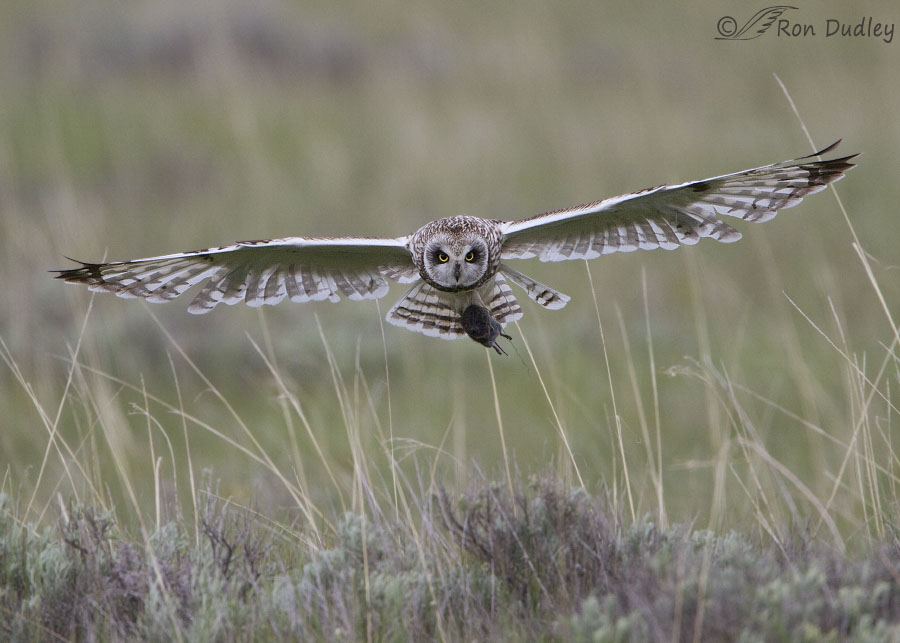
1/1250, f/5.6, ISO 800, Canon 7D, Canon EF 500mm f/4L IS USM + EF 1.4 III Extender, not baited, set up or called in
But now his concentration has drifted downward to the sagebrush sticking up in front of him.
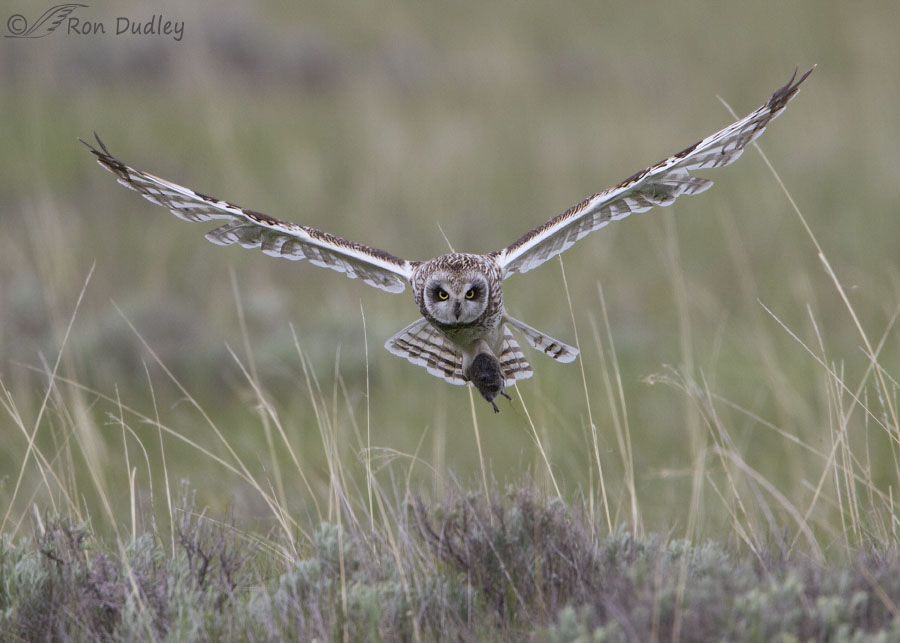
1/1250, f/5.6, ISO 800, Canon 7D, Canon EF 500mm f/4L IS USM + EF 1.4 III Extender, not baited, set up or called in
That sagebrush is his intended temporary perch.
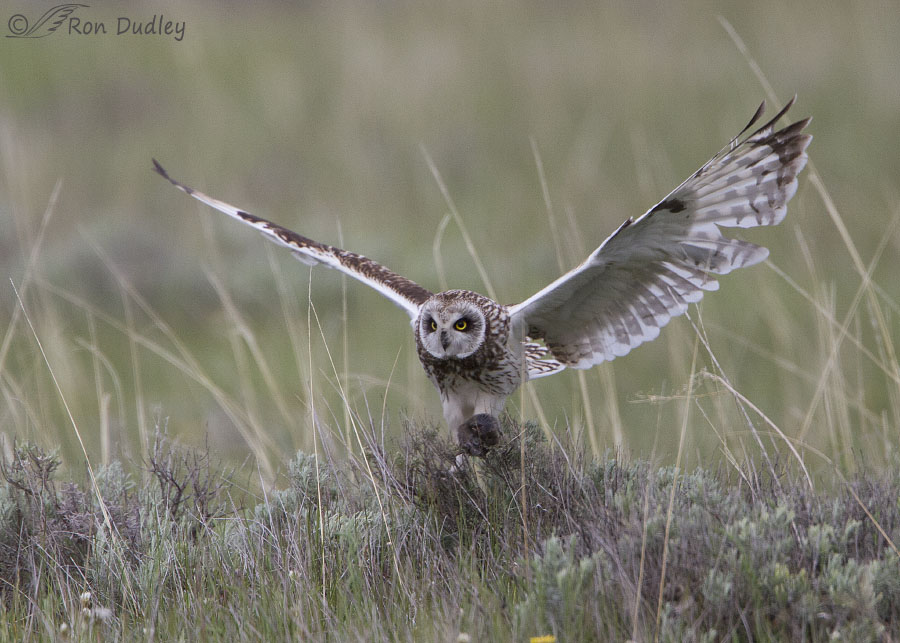
1/1250, f/5.6, ISO 800, Canon 7D, Canon EF 500mm f/4L IS USM + EF 1.4 III Extender, not baited, set up or called in
He landed on the sagebrush but only for a couple of seconds – in fact his stay was so brief he kept his wings out the entire time. Then in the wink of an eye he…
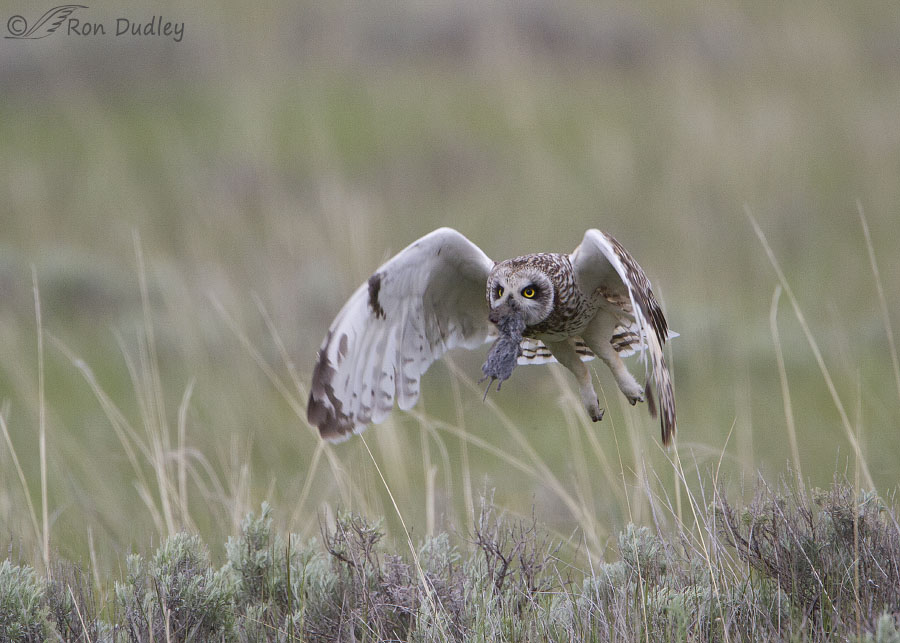
1/1250, f/5.6, ISO 800, Canon 7D, Canon EF 500mm f/4L IS USM + EF 1.4 III Extender, not baited, set up or called in
transferred the vole to his beak and took off in a single fluid motion. He did it so quickly I missed the transfer. From here he took the vole to his family at the nest far out of frame to the left.
What made this behavior so interesting for me is that he followed the same routine every time be brought a vole in. I saw him do it dozens of times over several days and each time he approached the general area of the nest with the vole in his talons, landed on one of two favorite perches for a few seconds (the other perch was a metal post out of frame to the right) and then transferred the vole from talons to beak before delivering the meal.
I have a theory as to why he always followed this unusual pattern instead of just flying to the nest with the vole in his talons. Twice I was in a position to see (through my long lens) him deliver the vole to his mate on the ground in front of the nest. Both times she was quite aggressive and threatening toward him and he was very timid being that close to her. He was obviously afraid of her (she’s significantly larger).
Like most raptors Short-eared Owls prefer to carry prey in their talons instead of their beaks (doing so is more aerodynamically efficient, it’s a more secure way of holding it and that way the possibly still-living prey doesn’t threaten their eyes). But just before he got to the nest this owl always landed briefly on a nearby perch where he transferred the rodent to his beak so he could more safely and quickly drop the vole a few inches in front of her and vamoose quickly (he always beat a hasty retreat). When raptors try to release prey from their talons they sometimes have to struggle to “unimpale” the prey from those sharp talons. I’ve seen Red-tailed Hawks lift and shake their foot slightly before the prey item would drop off (one time the prey was a very sticky duckling). They can reliably drop prey from their beak in an instant.
So that’s my theory, for what it’s worth. Right or wrong it seems logical to me.
Ron


Wow! wonderful series Ron!
Charlotte
Wonderful sequence and theory about the transfer from talon to beak. Perhaps another possibility is that the transfer leaves his talons free to fight off kleptoparasitism from another bird- although it’s hard to imagine stealing from this guy. Or the female might see it’s free talons and think twice about any sort of domestic violence.
Thank you, Lyle.
Beautiful series and commentary. We are all creatures of habit. I wonder how many mouths he was trying to feed? Might make a women cranky having hungry screaming offspring.
April, He was feeding two chicks and his mate on the nest.
Besutiful series…especially like first and second shots–with wonderful wing spread…interesting comments and observations…ingeresting, too, that indpite of her aggressive behavior he continues to bring food….
He was a great provider despite her “attitude”, Patty. Thanks.
I think you’re absolutely right, Ron, but there’s another aspect to that behavior. Landing first at a staging area (for lack of a better term to arrive in my brain and flow out through my fingers!), they’re also checking to see if another raptor is around so they don’t lead said raptor (if it’s there) directly to their nest. It’s a little fake out should anybody be watching! Raptors are far smarter than we know!! The Cornell redtails used this safety strategy routinely.
And just Oh WOW! Those head-on images are just spectacular, especially when he’s focusing on you and a possible threat! Gads but I love waking up to your posts!
I’ve seen raptors apparently use a “staging area” for the reason you mention too, Laura. Thanks.
Gorgeous shots, Ron. I’m always blown away by the wingspan of certain raptors. Wow. I’m sorry he’s working so hard only to be “owlpecked” at home. Of course, maybe she’s just tired of being cooped up all the time with the kids.
Thank you, Marty. In this species the male is never with the “kids” in the nest. The female stays with them and only he brings food to them (the female never does).
With the Cornell kids, the male will spell the female, getting just a few minutes of nest time with the kids as she does what she needs to do. But BR definitely rules that roost! She gives the male far more nest time during incubation, but when the kids arrive, the male had better stay away except to deliver food. She’s bigger and badder and I know I wouldn’t mess with a hormonal female redtail!
I wouldn’t mess with a hormonal female of any species! I even stay away from myself some days.
Marty, the first year with Mariah, when those hormones hit, she shot me a look that resonated in my soul because I KNEW that look. I’ve GIVEN that look! Roughly translated, it means, “Drop the quail, back up and no one will get killed!” Here we are 24 years later, and she just gave me that look day before yesterday. The hormonal I-will-kill-you behavior has begun
Great series Ron. Can you tell us more about just how the transfer from the talons takes place? In one shot it almost looks like the vole is cradled on the sagebrush, does he deposit the dead vole on the bush, then perch briefly and at once beak the vole from its resting place? Or does it usually touch down briefly with one talon and then go single talon to beak for the transfer?
Cheers
Dave, he would usually reach down with his head as the foot lifted the vole up to his face and make the transfer that way. Occasionally the process would occur in flight.
Poor Dad— such a good and faithful provider really deserves a mate who knows which side her vole is buttered on…….
Kris, It would be interesting to know if this behavior is typical of the species (my guess is yes) and if so how and why it evolved.
Fascinating.
Thanks, Arwen.
Interesting……… I’ve never noticed the transfer from talons to beak. That may be not being close enough to where the transfer would take place. It does make sense from a protection of their face and if the spouse is going to get nasty about it though! The vole in the beak does look pretty well mangled! Beautiful bird and shots of it. More winter on the way for us!
More winter on the way for us!
I can think of no other logical explanation for it, Judy. Thank you.
Hi Ron. Thanks again for the post AM and hope you are are on the mend. Great shots, but what strikes me the most about this post is the example of typical male/female behavior in many species, including humans. The guy gets the goods only to be yelled at once he gets it home. There’s just……..something not right here. Have a nice day!
Frank, I was surprised how aggressive she was toward him – completely unlike Red-tailed Hawks (for example) when they’re both on the nest with chicks and prey.
Excellent interpretation Ron, not to mention the great photos. I was watching a Pileated Woodpecker hole one year, and whichever parent was approaching the hole it would give a call, and the mate would fly out before the other bird entered the nest hole.
Brian
Thanks, Brian. Williamson’s Sapsuckers do it a little differently. One bird lands at the hole with the other one still in the cavity. The one inside pokes its head out, the one outside cocks it’s head to the side to get it out of the way and then the bird in the nest takes off explosively.